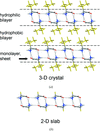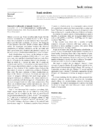issue contents
June 2009 issue

Cover illustration: Though cyclohexanol is a simple compound it has a rich phase diversity at low temperature. It forms a disordered glassy phase on cooling, but this can be transformed into ordered phases (II), (III) and the metastable (III'), which all have different hydrogen-bonding motifs. The series of transitions is attributable to the conformational flexibility of the hydroxyl group [Ibberson et al. (2008). Acta Cryst. B64, 573-582].
feature articles




research papers


















Periodic two-dimensional slabs and full three-dimensional networks were extracted from the X-ray structures of hydrophobic amino acids and then optimized with ab initio methods. The derived interaction energies support the observed propensity for inclusion of two molecules in the asymmetric unit.
addenda and errata

book reviews



 journal menu
journal menu

































